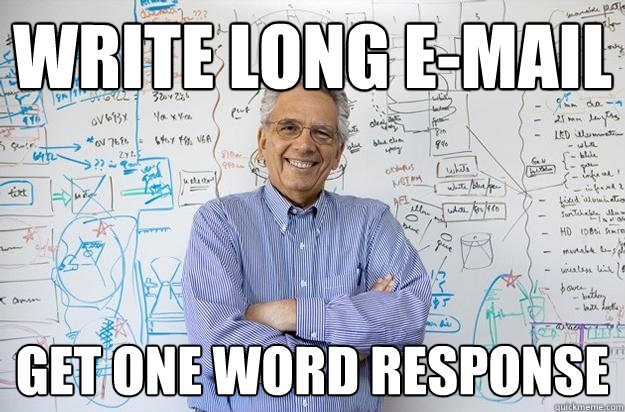Want to count the ways that e-mail is awful? Sure, let’s do that.
- It’s probably the biggest time-suck of the modern age.
- Even though it’s really easy to solve many work issues with a 5-minute convo, it always becomes a 61-person e-mail thread.
- No one understands the “push/pull” methodology.
- No one contextualizes any e-mail, so everyone thinks that everything is urgent.
- There’s somewhere between 89 billion and 135 billion e-mails sent for business every day in the world.
When you get right down to it, because of e-mails and meetings, you probably do about 590 hours of real, actual work in a given year. Ironically, you’re on the cross for a lot of that, I’m sure.
Here’s an interesting thing I’ve recently observed (by recently I mean “over the past 12 years”), and thought was deserving of a post.
I think there’s a general assumption that people don’t read e-mails of over a couple lines — I personally think Outlook and GMail and other business e-mail clients should just stop you from typing after a while — and there’s actual, documented research that Baby Boomers (who still run most businesses) hate long e-mails.
So you should make your e-mails shorter, right?
But wait.
When you send shorter, one-off e-mails — 2-3 lines talking about an issue or a problem — people tend to forget about those, especially if you’re not high-ranking-enough-for-them-to-care.
So you come to this crossroads:
- No one wants to read long e-mails.
- People forget about short e-mails.
What does one do?
I went and Googled “optimal business e-mail length,” because I’m an intrepid person. Google’s algorithm handed me this Hubspot post, although admittedly said post is more about e-mail marketing and less about, say, e-mailing your boss.
Thankfully, Fortune wrote a post on that a few years ago. Most of it is kinda garbage and obvious, but here’s something that more people should think about:
Tip 6. Make it easy to respond to your text. If the proof of the pudding is in the eating, then the proof of your writing is in your reader’s response. But remember that not responding is often a more convenient alternative. While it is hard to force a response, at least you can prod. To start with, make it clear, almost from the very first sentence, why you are writing to the reader and what you expect from her – business texts should not be mystery novels.
That’s the thing. People that perceive themselves as very busy want a clear “CTA” (call to action) on their e-mails. They want to know (a) the issue, (b) the solutions, and (c) what’s needed from them. If you run ’em down a rabbit hole explaining the end goal, they’ll ignore it regardless of length.
It would be cool if someday we could move to organic communication at work, but that might be a major pipe dream. So for the short-term? We need to figure out optimal length. And while there’s a million and five studies on subject line length, the literature and biz journalism on body length is a lot less. So, if nothing else, at least make “the ask” very plain and clear.

Great point, Ted. Short emails have their challenges too. This reminds me of a Dilbert comic which starts out, “I got your overly brief email, which means you hate me and everything I stand for!” http://dilbert.com/strip/2006-12-18.
Funny — and true.